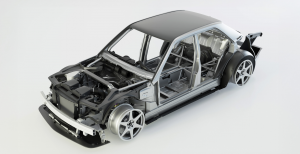
HWA reveals unprecedented engineering prowess beneath new HWA EVO
World-leading motorsport and automotive engineering firm HWA has shared further in-depth details of its cutting-edge supercar.
AFFALTERBACH, LONDON, GERMANY, November 13, 2024 /EINPresswire.com/ -- Following the global unveiling of its new HWA EVO super saloon earlier this year, world-leading motorsport and automotive engineering firm HWA AG (HWA) has shared further in-depth details of its cutting-edge supercar.
Built from the ground up, the HWA EVO holds true to the ethos of the legendary Mercedes-Benz 190E 2.5-16 EVO II. Limited to just 100 production examples, the HWA EVO is enhanced to provide a contemporary, ultra-focussed driving experience through the empathetic application of the very latest materials and technology, allied to the most advanced design, engineering and manufacturing techniques.
“The HWA EVO is far more than just a ‘restomod’. In order to fully realise our vision for the car we are going to unparalleled lengths in terms of design, engineering and suppliers,” said Gordian von Schöning, CTO of HWA. “Not only have we called upon our own decades of experience at the cutting edge of motorsport and supercar production, but we have leveraged techniques and partnerships that would normally only be found at major OEM level to ensure our car is worthy of the EVO name.”
Each HWA EVO build begins with a hand-selected Mercedes-Benz W201 donor vehicle, stripped back to its original steel chassis before being inspected and prepared to meet HWA’s strict quality criteria. In order to achieve modern performance and safety standards, however, extensive modifications are made even at this early stage.
The front and rear portions of the donor vehicle are removed and replaced with new motorsport-grade aluminium and high-strength steel subframes, designed in-house by HWA. This not only ensures contemporary impact performance and unprecedented safety in a car of this type, but allows the suspension to be mounted directly to the new chassis structure, creating a rigid platform for maximum handling precision and driver feedback.
The chassis is further modified to allow the 3.0-litre bi-turbo V6 powerplant to be mounted as low and as far back as possible: the front axle is moved forward by 50mm, ancillary components are repositioned, and the six-speed manual transmission relocated to the rear. This front-mid-engined, transaxle layout enables a targeted 50/50 weight distribution for motorsport-derived handling characteristics.
The retained steel midsection – including the A, B and C pillars – is then extensively reinforced, ensuring that energy is channelled effectively through the new, rigid structure. In contrast to the original W201 donor car, the HWA EVO now boasts more than double the torsional stiffness, comparable to a state-of-the-art production supercar. In all, approximately 75% of the original car is replaced, before the full chassis is electro, or KTL (Kathodische Tauchlackierung), coated for
OEM-level corrosion protection.
With the chassis prepared, engineers can then begin assembling the additional components which contribute to the HWA EVO’s formidable performance. While HWA leverages its extensive expertise to manufacture multiple bespoke components, including DTM-derived wishbones, billet-machined wheel carriers and various suspension parts, the company also leverages longstanding relationships with industry-leading partners to ensure cutting-edge performance.
Two brake options, steel and carbon ceramic, are supplied by Brembo, minimising rotating mass and unsprung weight. KW dampers, manually or electronically adjustable depending on vehicle specification, are custom designed for the HWA EVO. The kinematic nature of the suspension also enables camber optimisation under intense driving conditions, with stability further strengthened by anti-roll bars from H&R.
To appropriately cap such exceptional commitment to engineering detail, full carbon bodywork is fitted to the re-engineered chassis and frame. The bespoke mouldings not only include individual sections such as the doors and roof, but unprecedented single structures which encapsulate the entire front and rear ends of the vehicle. Manufacturing these areas as a single form is highly challenging, but allows for the bodywork to take on a structural element, contributing to the finished car’s exceptional rigidity while enabling its remarkably light kerb weight.
Throughout the process, motorsport precision is balanced with real-world reliability, durability, comfort and safety. In addition to intensive simulation programmes, this is underscored by the conduction of physical crash tests to ensure optimum occupant protection standards.
Images: https://www.dropbox.com/scl/fo/9dm5lqjm8m39amm8gpnmv/ANLtpO-h_QVEnqRX6YU6MGs?rlkey=g8fqbphhkxziptx53gb83vbk5&e=1&st=uoqlsx8r&dl=0
Steve brown
Influence Associates
steven@influenceassociates.com
Distribution channels: Automotive Industry
Legal Disclaimer:
EIN Presswire provides this news content "as is" without warranty of any kind. We do not accept any responsibility or liability for the accuracy, content, images, videos, licenses, completeness, legality, or reliability of the information contained in this article. If you have any complaints or copyright issues related to this article, kindly contact the author above.
Submit your press release
